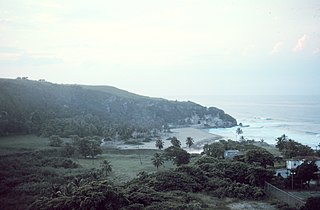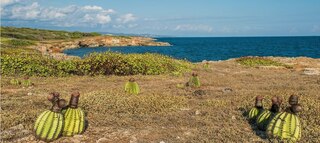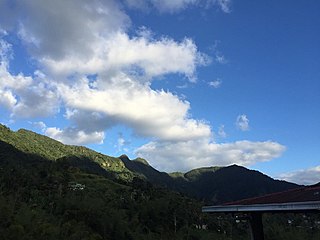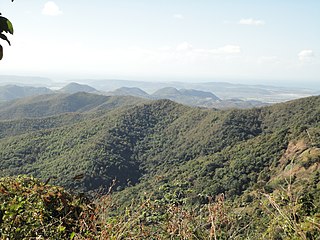
Quebradillas is a town and municipality of the island of Puerto Rico located in the northern shore bordering the Atlantic Ocean, north of San Sebastián; east of Isabela; and west of Camuy. Quebradillas is spread over seven barrios and Quebradillas Pueblo. It is part of the San Juan-Caguas-Guaynabo Metropolitan Statistical Area.

The Guánica State Forest, popularly known as the Guánica Dry Forest is a subtropical dry forest located in southwest Puerto Rico. The area was designated as a forest reserve in 1919 and a United Nations Biosphere Reserve in 1981. It is considered the best preserved subtropical dry forest and the best example of dry forest in the Caribbean.

Toro Negro State Forest is one of the 21 forests that make up the public forests system in Puerto Rico. It is also Puerto Rico's highest cloud forest. It is in the Cordillera Central region of the island and covers 8,204 cuerdas, of mountains. Toro Negro's mountains have heights reaching up to 4,400 feet (1,300 m) and include Cerro de Punta, Cerro Jayuya and Cerro Rosa, the three highest peaks in the island. Nested among these mountains is Lake Guineo, the island's highest lake. The forest has 18 kilometers (11 mi) of trails, an observation tower, two natural swimming pools (Spanish:"charcos"), camping and picnic areas, nine rivers, and numerous creeks and waterfalls. The forest spans areas within the municipalities of Ponce, Jayuya, Orocovis, Ciales, and Juana Díaz, and consists of seven non-contiguous tracts of land. The largest contiguous segment of the forest is located in the municipalities of Ponce and Jayuya. Some 40% of the area of Toro Negro State Forest is located in Ponce's Barrio Anón.
Cambalache State Forest and Reserve is a nature reserve and one of the 20 state forests in the territory of Puerto Rico. The Cambalache State Forest is located in the municipalities of Arecibo and Barceloneta in northern Puerto Rico.

Rio Abajo State Forest is a forest preserve in Puerto Rico owned by the Department of Natural Resources and one of the 20 state forests in the island. It was designated a National Natural Landmark in 1980 and constitutes an area of 3,590 acres. It consists mostly of subtropical wet and moist karst forest. Mogotes and sinkholes fill the landscape. The forest preserve is located in the municipalities of Arecibo and Utuado. In addition to its ecological value the forest also contains a number of archaeological sites.

The Northern Karst Belt is a limestone karst landscape located in the northwestern region of Puerto Rico. A karst is a topographical zone formed by the dissolution of soluble porous rocks, such as limestone, with features such as mogotes, canyons, caves, sinkholes, streams and rivers, all of which are common on this region of the island. Some of the island's main rivers, including its longest, traverse the karst and form some of the most distinctive Puerto Rican geographical features such as the Camuy caverns. Many of these rivers feed into and are important in the formation of many marshy areas such as the Caño Tiburones wetlands.

Carite State Forest is a state forest and nature reserve located in the Sierra de Cayey mountain range in southeastern Puerto Rico. The forest extends over approximately 2,600 hectares and is located in the municipalities of Caguas, Cayey, Guayama, Patillas and San Lorenzo. The forest is located along the Ruta Panorámica, which offers access to the forest.

Guilarte State Forest is one of the 20 forests that make up the public forests system in Puerto Rico. The forest is located in the eastern half of the Central Mountain Range or Cordillera Central. The main geographical feature of the forest reserve is Monte Guilarte, which is Puerto Rico's 7th highest mountain at 3,950 feet above sea level. While Monte Guilarte is located in the municipality of Adjuntas, the forest's borders also include parts of Guayanilla, Peñuelas and Yauco.

Los Tres Picachos State Forest is one of the 20 forests that make up the public forest system of Puerto Rico. The forest is located in the Central Mountain Range or Cordillera Central, along the Los Tres Picachos mountain ridge, one of the island's highest mountains, named after the distinctive three peaks of the highest mountain in the forest. The state forest is located in the municipalities of Jayuya and Ciales.

San Patricio State Forest, also known as the San Patricio Urban Forest is one of the 20 forests that make up the public forest system of Puerto Rico. This is a secondary or second-growth forest is located in the Gobernador Piñero district of San Juan, between the neighborhoods of Villa Borinquen, Caparra Heights and Borinquen Towers complex. The urban forest has entrances on Roosevelt Avenue and Ensenada Street. The forest extends to almost 70 acres and it is the smallest protected area in the Puerto Rico state forest system. One of the most distinctive features of the forest is the mogote on its northern edge which can be observed from many parts of San Juan and Guaynabo. The forest is part of the Northern Karst.

Nuevo Milenio State Forest is one of the 20 forests that make up the public forest system of Puerto Rico. The forest is located east of the University of Puerto Rico Botanical Garden in the Sabana Llana Sur district of San Juan, making it one of the two state forests located within the capital's municipal boundaries.

Bosque del Pueblo is one of the 20 forest units that make up the public forest system of Puerto Rico. The 738-acres forest is located in the municipality of Adjuntas and it comprises a preserved zone which was endangered of being developed as a quarry between the years 1980 and 1995. The forest is located in lands shared by the Adjuntas barrios or districts of Vegas Arriba, Vegas Abajo and Pellejas de Adjuntas. In addition to preserving the forest, the reserve is important to the preservation of the hydrological basins of the Pellejas and Viví Rivers, and many of the tributaries of the Arecibo River have their sources in the forest lands. The forest also functions as an ecological corridor between the Guilarte, Río Abajo and Toro Negro Forests.

Susúa State Forest is one of the 20 forest units that make up the public forest system of Puerto Rico. This forest is located in the southeastern foothills of the Central Mountain Range or Cordillera Central, in the municipalities of Sabana Grande and Yauco. Most of the forest, particularly the lower parts, are of secondary growth as the land had originally been deforested and used for cattle grazing, timber production and agriculture. The forest is an important habitat for the endangered Puerto Rican nightjar.

Boquerón State Forest is one of the 20 forestry units that make up the public forest system of Puerto Rico. Despite its name, the Boquerón State Forest is not only located in Boquerón, Cabo Rojo but also spans almost 5,000 acres across the municipalities of Cabo Rojo, Lajas and Mayagüez. The forest area is also known for its limestone cliffs, the lighthouse, and the salt flats which have been a source of salt since the pre-Hispanic era and, dating to 700 C.E., they are considered to be one of the oldest industries in the Americas.

Cueva del Indio is a seaside cave located along limestone cliffs in Islote, Arecibo along Puerto Rico's Atlantic coast. The cave and its surroundings are protected by the Puerto Rico Department of Natural and Environmental Resources (DRNA) as the Cueva del Indio Nature Reserve. The cave gets its name after the numerous petroglyphs created by the Taínos.
The Aguas Buenas Cave System is a cave system located in the municipality of Aguas Buenas. The caves and their surrounding forest area are protected by the almost 1,800-acre Aguas Buenas Cave and Caverns System Nature Reserve since 2002, which also extends to the municipalities of Caguas and Cidra. The reserve is important for the number of bat species found in the system, some of which are endangered. In addition to being an important bat preserve, the nature reserve protects an important hydrological basin which is the source of a number of rivers and creeks that form part of the Loíza River basin.

Vega State Forest is a state forest of Puerto Rico located in the municipalities of Vega Alta and Vega Baja. The subtropical moist forest is located in the northern coast of Puerto Rico in the middle of the karst zone known as the Carso Norteño, and it contains features typical of such geography such as sinkholes, caves and mogotes. It was designated a nature reserve in 1952 and it is fully protected by the Puerto Rico Forest laws of 1975. The forest has a total area of 1,150 acres, divided into six forest units throughout the municipalities of Vega Alta and Vega Baja.

Mona and Monito Islands Nature Reserve consists of two islands, Mona and Monito, in the Mona Passage off western Puerto Rico in the Caribbean. Mona and Monito Islands Nature Reserve encompasses both land and marine area, and with an area of 38,893 acres it is the largest protected natural area in the Commonwealth of Puerto Rico. Much like the Galapagos Islands in the Pacific Ocean, the Mona and Monito Islands reserve represents a living laboratory for archaeological, biological, geological, oceanographical and wildlife management research.

Punta Guaniquilla is a headland or small peninsula located immediately to the south of Buyé Beach and north of Boquerón Bay in the municipality of Cabo Rojo, Puerto Rico. The entirety of the headland is protected as the Punta Guaniquilla Nature Reserve by the Conservation Trust of Puerto Rico and the Puerto Rico Department of Natural and Environmental Resources since 1977, making it one of the oldest nature reserves officially protected by Puerto Rico Law #150.




















